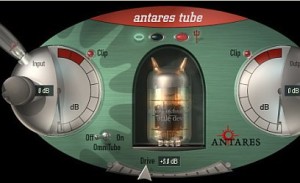Second option: This option is recommended for heavy rock distorted vocals. Antares Tube has two modes of distortion, the “Little Angel” which is the blue one and the “Little Devil” which has orange color in the tube. You can get the “Little Devil” mode by clicking red/fork symbol. Recommended Antares Tube settings:
Drive= +3.0dB to +6.0dB
Omnitube= Off
Mode= Little Devil
This is how the settings would look like in the plug-in. Take note that the color of the tube changes to orange because “Little Devil” mode is enabled.
This is the sample vocals applied with the effect settings above:
Third option: To get a much distorted vocals typically for some specialized genre in music. You can use the following settings:
Drive= +3.0dB to +6.0dB
Omnitube= On
Mode= Little Devil
Additional Tip: You can get a more dense/heavy vocal type which you will usually hear in alternative, pop and rock music. To do this, simply double the vocal tracks in your multi-track mix. Then apply only one vocal track with distortion. I usually panned this additional vocal track at right +15 units (or 15%).
In the multi-track screenshot above, the vocal tracks are doubled – one for lead vocal and the other one for the backup. The lead vocal is applied with very slight distortion for the entire vocal tracks. At the selected section of the track (example in the chorus section of the song), the backup vocal tracks have been added, doubling up the vocals and making it heavier by adding distortion effects. Do not overdo distortion; it depends on the tempo and genre of the music. Sometimes when you add distortion effects to vocals, make sure to double check that you can still understand the lyrics of the song, unless you decide that lyrics are not important in your production.
Other Creative Tips
Aside from distortion, you can use other FX such as chorus and flanger to add more taste to the vocals. The following are the important rules when applying these FX in vocals:
1.) Clarity should be emphasized more than FX. Sometimes if you increase the FX level (regardless of whether it’s a distortion, chorus, flanger, etc.), it tends to drown the vocals and the clarity would be severely affected.
2.) Use panning and double vocals. This will make it sound thick and rich.
3.) Use only for specific part of the vocals. Sometimes vocal distortion is creatively applied in some parts of the song where it fits. This can be the chorus or bridge or ending of the song. Using this for the entire vocal tracks is not recommended.
4.) Match with the tempo, vocal distortion works best in fast or mid tempo song.
5.) Match with the instrumentation, this effect works best when having a dense background (such as heavy guitars or bass). Of course, it will sound weird if you apply distortion to the vocals in an acoustic song 🙂
Content last updated on August 21, 2012

